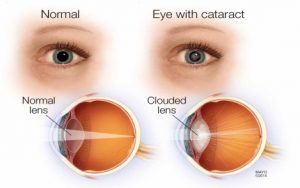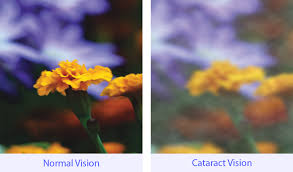
Cataract Surgery and Treatment in Bagdogra: Cataracts are changes in clarity of the natural lens inside the eye that gradually degrade visual quality. The natural lens sits behind the colored part of the eye (iris) in the area of the pupil, and cannot be directly seen with the naked eye unless it becomes extremely cloudy. The lens plays a crucial role in focusing unimpeded light on the retina at the back of the eye. The retina transforms light to a neurological signal that the brain interprets as vision. Significant cataracts block and distort light passing through the lens, causing visual symptoms and complaints. You can get your Cataract Surgery done in one of the best eye hospitals in Bagdogra, Vision Eye Care.
Cataract development is usually a very gradual process of normal aging but can occasionally occur rapidly. Many people are in fact unaware that they have cataracts because the changes in their vision have been so gradual. Cataracts commonly affect both eyes, but it is not uncommon for cataracts in one eye to advance more rapidly. Cataracts are very common, affecting roughly 60% of people over the age of 60.
Cataract is the leading cause of blindness in India. However, Cataract can be easily cured by replacing the cloudy lens with a clear artificial lens while performing a surgery by an experienced Cataract Surgeon.
The lens is made mostly of water and protein. Specific proteins within the lens are responsible for maintaining its clarity. Over the years, the structures of these lens proteins are altered, ultimately leading to a gradual clouding of the lens.
Uncommonly, cataracts can present at birth or in early childhood as a result of hereditary enzyme defects, and severe trauma to the eye, eye surgery, or intraocular inflammation can also cause cataract to occur earlier in life. Other factors that may lead to development of cataracts at an earlier age include excessive ultraviolet-light exposure, diabetes, smoking, or the use of certain medications, such as oral, topical, or inhaled steroids.
Having cataract is often compared to looking through a foggy windshield of a car or through the dirty lens of a camera. Cataracts may cause a variety of complaints and visual changes, including: blurred vision, difficulty with glare (often with bright sun or automobile headlights while driving at night), dulled color vision.

Symptoms can be increased near sightedness accompanied by frequent changes in eyeglass prescription, and occasionally double vision in one eye. A change in glasses may help initially once vision begins to change from cataract; however, as cataract continue to progress and opacity increases, vision becomes cloudy and stronger glasses or contact lenses will no longer improve sight.
Cataract is usually gradual and not painful or associated with any eye redness or other symptoms unless they become extremely advanced. Rapid and/or painful changes in vision are suspicious for other eye diseases and should be evaluated by an eye-care professional.
To detect a cataract, the eye-care provider examines your lens. A comprehensive eye examination usually includes the following:
With recent advances in techniques of Cataract surgery, it is not advisable to allow cataract to mature or harden. The harder the cataract, more phaco energy is needed, which causes more stress on cornea. Conventional Intra capsular and Extra Capsular techniques were for a very long time the preferred techniques for cataract removal, but the use of these techniques require large incision (Cuts) and stiches. The healing process takes longer.
Currently Phacoemulsification is the procedure of choice for cataract removal. It is a very precise and less invasive procedure which gives excellent results in expert hands. Vision Eye Care is equipped with the state of art Catharex 300 phaco machine from Ortley, USA. Vision Eye Care also provides the MICS technique, the latest procedure in cataract removal which has made implantation of IOLs more comfortable for patient with highest precision of results.
Operating microscopes are from Carl Zeiss, Germany, which have excellent optical visualisation system and aid in tracking the minutest of the changes while operating.
After removal of cataract with phacoemulsification technique, the surgeon implants an artificial lens in the eye which enables us to see after cataract surgery.
Yes, it does. There are four basic types of lens:
Hydrophobic acrylic lenses are supposed to be the best.
Cataract surgery is a day procedure where the patient will be able to go home on the same day. Your cataract surgery recovery should be short and uneventful, as long as your health is good and you don’t have other major eye problems. Statistics also show that your chances of a good outcome and sharper vision after surgery are excellent.
Uncomplicated cataract surgery often takes no longer than about 10 minutes to perform. But immediately after the surgery, you will need to rest in a recovery area until you are less groggy from sedation or anesthesia. Typically this takes about 30 minutes to an hour.
You must have someone available to drive you home after the procedure. You’ll be given a pair of dark goggles to wear on the trip home to protect your eye from bright light and glare.
If you are sleepy or tired when you get home, you might want to rest in bed for a few hours. Depending on your cataract surgeon’s advice, you may be able to remove the protective shield placed over your eye within several hours after the procedure.
Just remember that you will need to tape the shield back over your eye at night or during naps, for protection while you recover from cataract surgery, at least for several days.
Your eye doctor typically will prescribe antibiotic eye drops to prevent infection and anti-inflammatory eye drops to help reduce any internal inflammation. You’ll need to apply the eye drops several times daily for about the first week during your cataract surgery recovery. Depending on the amount of postoperative inflammation you have, you may need the drops for a few weeks to a month. Make sure you use these eye drops and any oral medications exactly as prescribed.
Many patients report clear vision within several hours after cataract surgery. But each person heals differently, and you may need as long as a week or two before you see images in their sharpest focus.
Typically, you will have a follow-up appointment with your cataract surgeon the day after the procedure to make sure there are no complications. If you don’t notice any improvement in blurry vision or you feel eye pain or significant discomfort in the days following this visit, you should report this to your surgeon.
For a safe and speedy cataract surgery recovery, follow these tips:
For the best cataract surgery recovery possible, follow your surgeon’s detailed instructions about how to protect your eye following your procedure. Usually these instructions will be given to you as a handout that you can take home with you on surgery day.